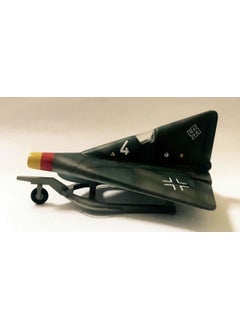Free & Easy Returns
Best Deals


| Material | Plastic |
PM Model 224 1/72 LIPPISCH P.13a Fighter Aircraft Disassembled Plastic Model
SCALE: 1/72
Type: Disassembled Kit (Requires assembly and painting)
MATERIAL: PLASTIC
CONTENTS:
Plastic Injection Parts
1 Decal
1 Installation Manual
FEATURES:
It is made of disassembled plastic.
Glue and paint are not included in the box.
You can easily carry out the necessary assembly operations with the included assembly guide.
ABOUT:
Designed by Josef Hubert in 1942, the Lippisch S.13 is a high-speed bomber. It was a tailless, swept-wing design with an engine and propeller mounted at both the front and rear of the aircraft, in a highly unusual configuration. A large ventral fin gave it an almost cruciform cross-section. The solid-fuel-powered P.13 was one of several distinct Lippisch design studies so designated and designated P/13a. It had almost the same form variations as the P.12 presented in a brochure, with large aileron and integral raised cockpit and an articulated, double-hinged landing skid. The trailing edge of the wing is slightly angled forward and the downward-pointing tip surfaces are discarded. The outer wing sections could be folded upwards for transport by rail. A variant with a rectangular front wing was tested in a wind tunnel. This was not really consistent with ramming, and there are other indications that conventional gun armament was considered. Since conventional fuels were extremely inadequate in late 1944, Lippisch proposed that the P.13a be powered by coal. Lippisch soon concluded that this could be even more effective than liquid fuel, because the location of combustion could be controlled more precisely. It was originally proposed to use a wire mesh basket holding equal-sized brown coal granules, positioned in the lower zone of the internal airflow. Burning coal gave off carbon monoxide (CO) gas, which was mixed with the upper air flow downstream and burned. The arrangement proved inefficient. Instead, a rotating circular basket was developed that spins on a vertical axis at 60 rpm. The hot exhaust will be mixed with cooler bypass air to increase thermodynamic efficiency before being expelled through the rear nozzle. Other fuels considered promising due to their ability to produce flammable steam include bituminous coal or pine wood soaked in oil or paraffin. A burner and drum were built and successfully tested in Vienna.

